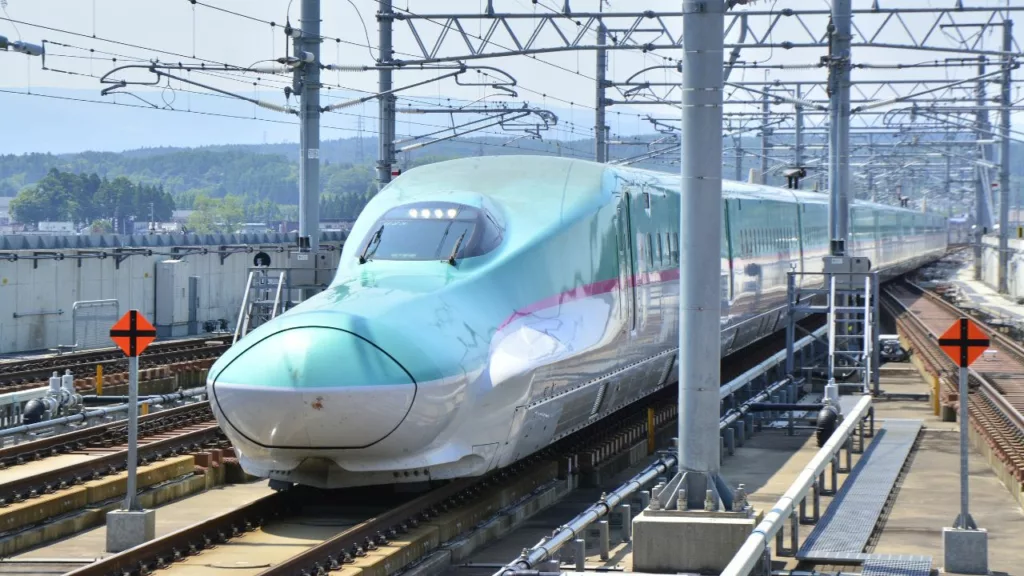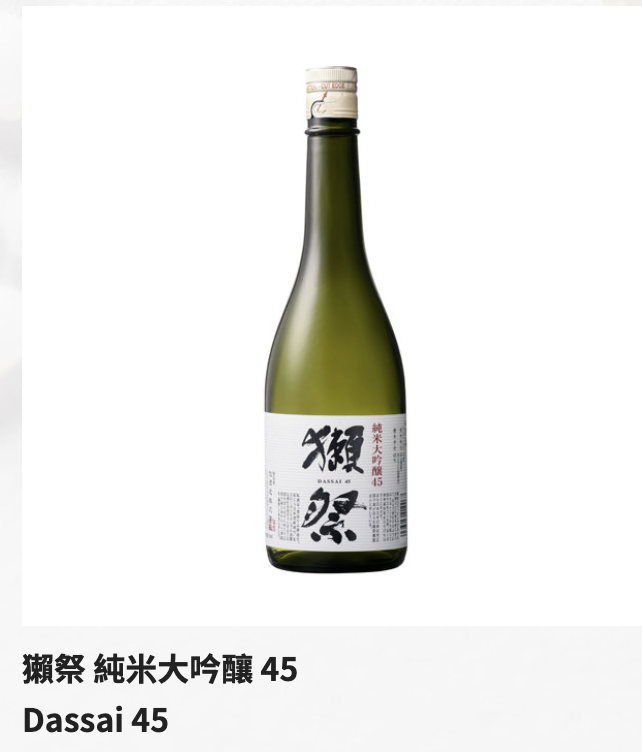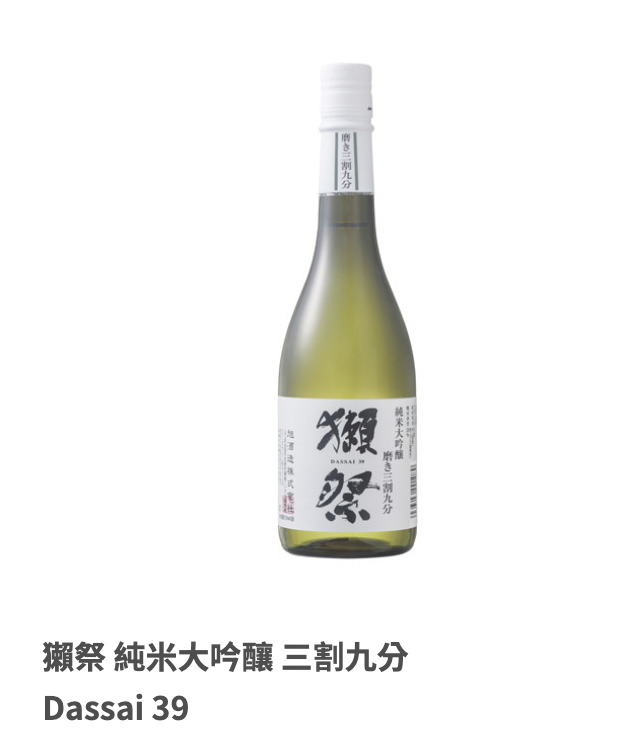快速導覽
A Must-See Shopping List for Sake Beginners
If you are new to Japanese sake, you are just beginning to be fascinated by Japanese sake. I believe that every time you go to a Japanese sake specialty store or a Japanese sake counter in a department store, you will find it a little difficult. In addition to being among dozens of brands, I don’t know which brand is more reliable, and I don’t know which brand will suit my taste, and I am very afraid of spending money on some bad sake.
Another point that is most difficult for beginners of sake is probably that different sake will have different "rice polishing steps", sometimes it will be 70%, 50%, and sometimes it will be 30%, 23%. It seems that as long as it is " The lower the value of "polished rice step" is, the higher the price of sake will be.
In addition, some brands of sake will also be marked as "raw sake", "no filtration", "zhongtori", "low temperature aging", etc. If you don't study sake deeply, you will basically not be able to distinguish the difference Value among sake. If you are unlucky, you may be sold mid-level quality sake by unscrupulous wine merchants at a high price, and you think you are buying some rare and limited high-end products.
In today’s article, I will introduce a few brands that are easy to buy in general department stores. Not only the quality is guaranteed, but also the price is reasonable. It is very suitable for sharing with friends on daily festivals. It doesn’t matter if other people don’t drink Japanese sake too often, the following brands of sake are some approachable, floral and fruity sake choices.

One ticket, unlimited travel throughout Japan!
[Best Deal] JR Pass All Japan Rail Pass
A must-have ticket for a long-distance trip to Japan!
The relationship between rice polishing and sake price
As long as you pay attention to sake for a period of time, I believe you will find that the lower the value of "rice polishing step" of sake, the higher the price of sake? In fact, the reason behind it is that the value of "polished rice step" means how much brown rice is needed to make wine. To put it simply, the lower the value of "rice polishing", the more brown rice (raw material) is needed to brew the same amount of sake.
In fact, the winery needs to spend time grinding the brown rice before actually brewing each bottle of sake. And the lower the value of "polished rice step", the more time will actually be spent behind it. Also because the time required for the rice polishing process increases geometrically, even if it is sake with a value of 30% for "rice polishing", the demand for raw materials may be double that of 60% for the lower the value of "polishing rice", but the final price will be due to consumption. The reason for the long time is far more than double the selling price.
For beginners in sake, they don’t necessarily need to be obsessed with the value of the “polished rice step”, nor is it that the lower the value of the “polished rice step”, the better it is, and the value of the “polished rice step” exceeds a certain number. Low grade sake. On the contrary, a sake that can be bought at a reasonable price, can experience the aroma and characteristics of sake, and can match the meal at that time is a sake worth trying.
Of course, some people will say that the lower the value of "rice polishing", the more obvious the aroma and fruity taste of sake. This is indeed true. Many sakes with fruity and floral aromas have a value of "rice polishing" lower than 50%. But in many cases, the usual habit of drinking sake is to enjoy it with different ingredients at the same time. If some greasy food is paired with sake with a low value of "rice polishing", the greasy food will overwhelm the sake. aroma, wasting an expensive sake.
So the value of "polished rice step" must be as low as possible? Not necessarily, on the contrary, it is better to decide whether to simply drink it or enjoy it as a table wine before buying, so that you can choose the most suitable sake.
5 Recommended Sake Brands for Sake Beginners
If you are all attracted by sake, which is transparent, but fruity and fragrant liquid, I believe that as long as you choose any of the following 5 brands of sake, you can share it with your buyers. Japanese sake is the easiest Fascinating place.
Dassai
A distillery from Yamaguchi Prefecture that focuses on the production of pure rice daiginjo (polished rice is less than 50%), and because Dasai’s brewing process is completely scientific and mechanical, the sake produced every year can be Maintain the same quality and flavor.
The more famous sakes are "Dasai - 4 parts and 5 parts", "Dasai - 3 parts and 9 parts", "Dasai - 2 parts and 3 parts". The difference is that the "four cuts and five points" (only 45% of brown rice left) has a relatively high value of polished rice, and the taste is a bit more mellow, while the "two cuts and three points" (only 23% of brown rice left) The aroma brought out by drinking it will be more prominent.
Although Dassai will have other special products, for beginners who are just starting to drink Japanese sake, "Dassai-Four and Five" can fully experience the characteristics of Dassai. Other Dassai sake needs to be passed through continuously. By comparing and tasting the drinking materials, you will find the mystery.
How to drink: Dasai’s sake is mainly sake with a strong aroma, so it is more suitable for cold drinking, so that the unique aroma will not be evaporated during the heating process.



Hakkaisan
Hakkaisan from Minamiuonuma City, Niigata Prefecture, is simply a winery operating in Snow Country.
Among them, the most worth trying sake is the pure white bottle, "Junmai Ginjo Hakkaisan snow room storage for 3 years", which is to store the brewed sake in the snow room with natural refrigeration method for 3 years, and make the sake The wine becomes more rounded and smooth before being bottled for sale. Generally speaking, sake is produced and sold in the same year. In fact, sake that is stored for three years before being sold is not very common, and it can be said to be a relatively rare variety.
Moreover, it is not very expensive in terms of selling price. If you consider the cost of storing it for 3 years, it is actually very worth trying!
How to drink: Hakkaisan produces a total of more than ten different products, some are suitable for heating up to +60 degrees, and some are only suitable for cold drinks. As for the "Junmai Ginjo Hakkaisan snow room storage for 3 years", the "polished rice step" is 50%. If you choose cold drinks, the white gas in the sake will not evaporate.

Kubota Kubota
Kubota, from Nagaoka City, Niigata Prefecture, is a brand that specializes in producing high-quality sake just like Hakkaisan. Among the famous sake are "Manju" (junmai ginjo), "senju" (ginjo), and "koju" (junmai ginjo). Among the three types, "Wan Shou" is the one with the most prominent aroma, and "Qian Shou" tastes more pungent after drinking. If you prefer sake with a more prominent aroma, you can try "Manju" first.
How to drink: Generally speaking, "Wan Shou" is suitable for drinking cold or at room temperature. Although it is not impossible to drink after heating, the aroma of the wine will decrease after heating, and the pungent taste of alcohol will become more prominent. If you don't drink sake often, you may find it very unpleasant.

Make Zaku
"Saku" from Suzuka City, Mie Prefecture. Although this brand is not as famous as Dassai, it has won many awards in different sake competitions. Among them, the most suitable for beginners of sake to try are their "Gennochi", "Honochi", and "Eunochi". The most attractive thing is that these sakes have a very prominent aroma of apple and pear, and there is even a little taste of apple in the transparent wine body.
Tasting method: Different from other brands of sake, it is probably because the raw material of sake brewing rice is not the same, so even after heating, it is still suitable for drinking, but the taste will change slightly. If you like to change If you are a sake lover, you must not miss this brand.

Sharaku
Saura from Aizuwakamatsu City, Fukushima Prefecture, I believe that many people will avoid Fukushima as soon as they hear it? But to be honest, Sara has rich brewing technology, water resources, and rice production, and is good at using different rice types to brew the most suitable sake. Among them, the "Sake Mirai" series is brewed using the rare variety of sake brewing rice "Sake Mirai" in Yamagata Prefecture. The aroma is so prominent that sometimes it is not easy to tell whether you are drinking sake or eating fruit.
How to drink: Just like other junmai daiginjo sake, it is best served cold.

Points to pay attention to when buying sake
Although I am a novice in sake, I need to prepare some basic knowledge when buying sake, because only in this way will I not be deceived by some unscrupulous wine merchants or retailers who have no knowledge of sake and sell them at high prices Some defective items with damaged quality.
Pay attention to how sake is stored
Generally speaking, Japanese sake is not sealed with a cork cork like red wine, but with a metal cap. If you go to the sake display cabinet and find that the Japanese sake is placed horizontally like red wine, you can basically buy all the sake in this store.
That's because when the water content of the sake and the sake come into contact with the bottle cap, the bottle cap will be easily oxidized, which in turn affects the quality of the sake. Of course, it does not mean that sake cannot be placed horizontally for a second, but if the stores that sell sake are accustomed to placing sake horizontally, it means that it is likely to have been placed for a while. The quality of sake may also be affected by the oxidation of the bottle cap.
Pay attention to the temperature at which sake is stored
Generally speaking, sake needs to be stored in a cool place that is not easily affected by moisture. Especially in the hot summer environment of tropical regions such as Taiwan and Hong Kong, sake is actually more suitable for long-term storage in refrigerators, and it is not sold until it is needed. The sake is taken out of the refrigerator and handed over to the customer. In this way, the quality of sake will not be easily deteriorated due to the high temperature environment.
But there are also some wine merchants who like to put sake for sale in display cabinets, and because they are worried that customers will not see it, they need to add a few high-temperature quartz lamps to illuminate sake products
In fact, the body of sake is as fragile as milk. Basically, as long as it is placed in a slightly high temperature environment for a long time, the body of sake will become sour and bitter. Therefore, if you find that the shops that sell sake have the habit of "letting the burner shine on the sake", you must think more about it before buying sake from them.
Pay attention to the date of manufacture of sake
Although general sake products do not have a clear expiration date, in order to taste the best quality of sake, it generally needs to be completely consumed within one year after leaving the factory.
The biggest difference between sake and red wine is that ordinary sake does not have the habit of "aging" after it leaves the factory. Even if it is necessary to make aged sake, it will usually be matured in the winery. Just seal the bottle. So don’t be too happy if you find sake that has been placed for several years on the wine cabinet of some wine merchants. Completely destroy all your good impressions of sake.
Summarize
The world of sake is actually very vast. In terms of the number of breweries alone, there are hundreds of them, each of which has more than ten kinds of sake products on sale. In order to truly understand the characteristics of each winery and each sake, it is necessary to compare and drink continuously to truly understand the uniqueness of each sake.
However, for sake beginners, if you simply want to experience the appeal of Japanese sake, you can actually start with the shopping list shared today. First get to know different brands, and then find out which type of sake you like the most. Do you like a stronger wine? Or do you like fruity and aroma? Once you have a direction, it will be easier to find more sake styles that suit you!
In addition, if you plan to buy sake during your trip in Japan, you can also learn about the 5 points that you need to pay attention to when buying sake in Japan. What are the most recommended places to buy sake? Are there places where sake must not be bought?
further reading: Where to Buy Japanese Sake? Complete Guide to Buy Sake in Japan
Finally, if you are planning to travel to Japan, you can also make more use of the travel information sharing on this website, maybe some travel itineraries will suit you!

More Japanese fun tips
communication, transportation
How to Use Suica Card with Apple Pay on iPhone?
Low-cost method to call to Japan by Skype: Step-by-Step Guide
Japan Internet SIM Card Recommendation "Which phone card is the best among plans with unlimited data and unlimited speed?
Which Side Should You Stand? Rules in Escalator in Japan
Best Japan Travel Apps: Public Transport App, Rail Route App , Weather Forecast App and More
Shopping Advice, Offers
Where to Buy Japanese Sake? Complete Guide to Buy Sake in Japan
Best Sake for Beginners: Complete Guide to Pick the Best Sake for Yourself
Itinerary suggestion
Itinerary suggestions for visiting Japan for the first time and traveling alone
5 Cat Islands in Japan: Meeting Cats in Tokyo, Shikoku and Fukuoka
More Japan Travel Information:
Tokyo|Kyoto|Hokkaido|Climbing Mt.Fuji|Hakone|Lake Kawaguchi
Tips for Traveling in Japan | Japan Hotel Deals | Klook Latest Promo Code
